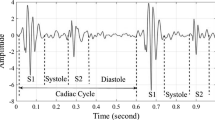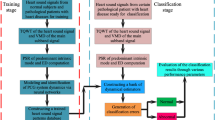Abstract
Auscultation, the listening process for lung sound using acoustic stethoscope, is the first physical examination used to detect any disorder in heartbeat system. Unlike sophisticated tools, stethoscope is not beyond the reach of rural hospitals and clinics. However, the use of acoustic stethoscope needs specialized and well-experienced physicians. This is mainly due to limited sound amplification of the stethoscope to the extent that the human ears may fail to recognize the pathological sound, and hence, the diagnosis may be erroneously classified. Models that make use of screened digital, instead of acoustic, stethoscope, in which heart sound is digitized and stored, becomes one of the most popular techniques because it allows computer-aided software to perform automated analysis. In this paper, a complete algorithm for automatic heartbeat detection and disorder discrimination is presented. The technique takes the advantage of spectral analysis to separate the first and second heart sounds (S1 and S2) using a power threshold. The frame duration is dynamically estimated, according to duration of the sound to be analyzed (S1 or S2). As typical recordings of heart sounds are periodic with several cycles, two methods to combine MFCC estimates are proposed. Using 450 cardiac ausculatory with both pathological and normal heartbeats, the proposed methods were examined using a cross-validation strategy based on tenfold. More than 90%, at best, sensitivity and specificity, respectively, were obtained for the two methods using an artificial neural network classifier with multilayer perceptron. The solution takes the advantage of recent technology and digital advances, in which it is possible to connect the digital stethoscope to any digital device to conduct further analysis using computer-aided applications. The technique is practical as it can be available at different hospitals and clinics, including those in rural areas, with limited resources.

















Similar content being viewed by others
References
Acharya UR, Oh SL, Hagiwara Y, Tan JH, Adam M, Gertych A et al (2017) A deep convolutional neural network model to classify heartbeats. Comput Biol Med 89:389–396. https://doi.org/10.1016/j.compbiomed.2017.08.022
Alfaras M, Soriano MC, Ortín S (2019) A fast machine learning model for ECG-based heartbeat classification and arrhythmia detection. Front Phys 7:103
Amiri AM, Armano G (2013) Detection and diagnosis of heart defects in newborns using CART. J Life Sci Technol 1(2):103–106
Ari S, Saha G (2007) In search of an SVD and QRcp based optimization technique of ANN for automatic classification of abnormal heart sounds. Int J Biomed Sci 2(1):1–9
De Lannoy G, François D, Delbeke J, Verleysen M (2012) Weighted conditional random fields for supervised interpatient heartbeat classification. IEEE Trans Biomed Eng 59:241–247. https://doi.org/10.1109/TBME.2011.2171037
El-Hanjouri M, Alkhaldi W, Hamdy N, Alim OA (2002) Heart diseases diagnosis using HMM. In: 11th Mediterranean Electrotechnical Conference, 2002. MELECON 2002. IEEE, pp 489–492
Fu W, Yang X, Wang Y (2010) Heart sound diagnosis based on DTW and MFCC. In: 2010 3rd International Congress on Image and Signal Processing (CISP), vol 6. IEEE, pp 2920–2923
Gamit MR, Dhameliya K, Bhatt NS (2015) Classification techniques for speech recognition: a review. Int J Emerg Technol Adv Eng 5(2):58–63
Garcia G, Moreira G, Menotti D, Luz E (2017) Inter-patient ECG heartbeat classification with temporal VCG optimized by PSO. Sci Rep 7(1):10543
Ghassemian H, Kenari AR (2016) Early detection of pediatric heart disease by automated spectral analysis of phonocardiogram in children. Inf Syst Telecommun 3:66
Güraksın GE, Ergün U, Deperlioğlu Ö (2011) The analysis of heart sounds and a pocket computer application via discrete Fourier transform. Fourier transforms: new analytical approaches and FTIR strategies
Jing Z, Wei H, Chunmei D, Xiaosheng Q (2008) Computer based analysis and recognition of heart sound. In: 2008 2nd International Conference on Bioinformatics and Biomedical Engineering
Kachuee M, Fazeli S, Sarrafzadeh M (2018) ECG heartbeat classification: a deep transferable representation. In: 2018 IEEE International Conference on Healthcare Informatics (ICHI). IEEE, pp 443–444
Kiranyaz S, Ince T, Gabbouj M (2016) Real-time patient-specific ECG classification by 1-D convolutional neural networks. IEEE Trans Biomed Eng 63:664–675. https://doi.org/10.1109/TBME.2015.2468589
Krasteva V, Jekova I, Leber R, Schmid R, Abacherli R (2015) Superiority of classification tree versus cluster, fuzzy and discriminant models in a heartbeat classification system. PLoS ONE 13:e0140123. https://doi.org/10.1371/journal.pone.0140123
Li H, Yuan D, Ma X, Cui D, Cao L (2017) Genetic algorithm for the optimization of features and neural networks in ECG signals classification. Sci Rep 7:41011. https://doi.org/10.1038/srep41011
Liu M, Wan C (2001) Feature selection for automatic classification of musical instrument sounds. In: Proceedings of the 1st ACM/IEEE-CS Joint Conference on Digital Libraries (JCDL ‘01). ACM, New York, NY, USA, pp 247–248
Manimurugan S, Narmatha C (2015) Secure and efficient medical image transmission by new tailored visual cryptography scheme with LS compressions. Int J Digit Crime Forensics: IJDCF 7(1):26–50
Manimurugan S, Porkumaran K, Narmatha C (2014) The new block pixel sort algorithm for TVC encrypted medical image. Imaging Sci J 62(8):403–414
Mayorga P, Druzgalski C, Calderas D, Zeljkovic V (2014) Multimodal classification of heart sounds attributes. In: 2014 Pan American Health Care Exchanges (PAHCE). IEEE, pp 1–6
Mokhlessi O, Rad HM, Mehrshad N (2010) Utilization of 4 types of Artificial Neural Network on the diagnosis of valve-physiological heart disease from heart sounds. In 2010 17th Iranian Conference of Biomedical Engineering (ICBME). IEEE, pp 1–4
Narmatha C, Manimegalai P, Manimurugan S (2017) A lossless compression scheme for grayscale medical images using a P2-bit short technique. J Med Imaging Health Inform 7(6):1196–1204
Narmatha C, Manimegalai P, Manimurugan S (2017) The secure lossless compression scheme for grayscale medical images using PBT and modified steganography. J Adv Res Dyn Control Syst, Issue. 03-Recent Trends in Engineering and Managerial Excellence, pp 96–103
Narmatha C, Manimegalai P, Manimurugan S (2018) A grayscale image hiding encode scheme for secure transmission. Curr Signal Transduct Ther 13:1–6
Ning J, Atanasov N, Ning T (2009) Quantitative analysis of heart sounds and systolic heart murmurs using wavelet transform and AR modeling. In: Annual International Conference of the IEEE Engineering in Medicine and Biology Society, 2009. EMBC 2009. IEEE, pp 958–961
Rachna X, Singh D, Vikas Y (2014) Feature extraction from asthma patient’s voice using mel-frequency cepstral coefficients. Int J Res Eng Technol 3(6):273–276
Sannino G, De Pietro G (2018) A deep learning approach for ECG-based heartbeat classification for arrhythmia detection. Future Gener Comput Syst 86:446–455
Scirè A, Tropeano F, Anagnostopoulos A, Chatzigiannakis I (2019) Fog-computing-based heartbeat detection and arrhythmia classification using machine learning. Algorithms 12(2):32
Sultan Qurraie S, Ghorbani AR (2017) ECG arrhythmia classification using time frequency distribution techniques. Biomed Eng Lett 7:325–332. https://doi.org/10.1007/s13534-017-0043-2
Tomas B, Rončević Ň (2009) Spectral analysis of heart murmurs in children by Goertzel algorithm. In: Future Computing, Service Computation, Cognitive, Adaptive, Content, Patterns, COMPUTATIONWORLD’09 Computation World. IEEE, pp 612–615
Turkoglu I, Arslan A (2001) An intelligent pattern recognition system based on neural network and wavelet decomposition for interpretation of heart sounds. In: Proceedings of the 23rd Annual International Conference of the IEEE Engineering in Medicine and Biology Society, 2001, vol 2. IEEE, pp 1747–1750
World Health Organization (2019) Cardiovascular diseases. https://www.who.int/cardiovascular_diseases/en/. Accessed June 2019
World Health Organization (2019) Cardiovascular diseases key facts. https://www.who.int/en/news-room/fact-sheets/detail/cardiovascular-diseases-(cvds). Accessed May 2019
Wu H, Kim S, Bae K (2010) Hidden Markov model with heart sound signals for identification of heart diseases. In: Proceedings of 20th International Congress on Acoustics (ICA), Sydney, Australia
Xingming G, Shouzhong X, Jing P, Yan Y, Xin T (2007) Heart sound recognition algorithm based on probabilistic neural network for evaluating cardiac contractility change trend. In: IEEE/ICME International Conference on Complex Medical Engineering, 2007. CME 2007. IEEE, pp 260–264
Zhou HB (2012) Identity recognition using heart sound based on HHT. In: 2012, 31st Chinese Control Conference (CCC). IEEE, pp 3596–3600
Author information
Authors and Affiliations
Corresponding author
Additional information
Publisher's Note
Springer Nature remains neutral with regard to jurisdictional claims in published maps and institutional affiliations.
Rights and permissions
About this article
Cite this article
Mustafa, M., Abdalla, G.M.T., Manimurugan, S. et al. Detection of heartbeat sounds arrhythmia using automatic spectral methods and cardiac auscultatory. J Supercomput 76, 5899–5922 (2020). https://doi.org/10.1007/s11227-019-03062-7
Published:
Issue Date:
DOI: https://doi.org/10.1007/s11227-019-03062-7




